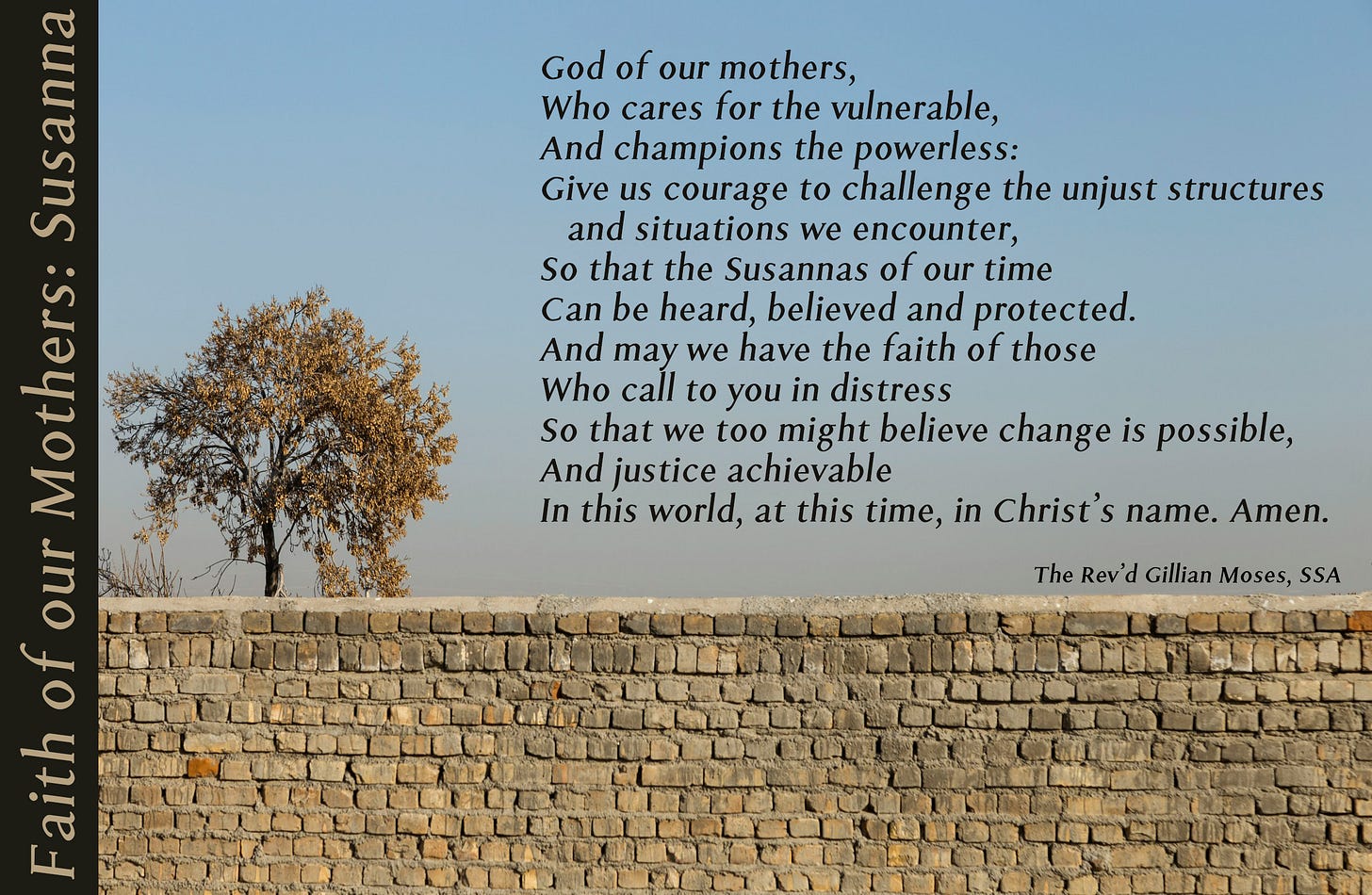I have a very exciting announcement this week!
Rev Gillian Moses SSA, who has written this post about Susanna, is the first of many new contributors in this series! What that means is, as we bring you the voices of the women of the Bible, you will hear them through the voices of lots of different women with lots of different perspectives and ministries today.
If you would like to be a contributor, or if you know someone who would love to be involved, please message me!
The story of Susanna is found in the Septuagint (Greek) version of the Book of Daniel, either as part of the Apocrypha, or as Chapter 1 or Chapter 13 of Daniel in the Catholic Canon. It is not traditionally included in the Hebrew Canon. The attempted rape of Susanna by two of the Elders of the community, and her subsequent trial for adultery begins the story. Her rape is interrupted by her cries of distress and the two old male perpetrators claim to have caught her in adultery to justify their presence in her private garden. The trial goes badly for Susanna, when nobody comes to her defence. In hopeless despair she cries out to God, and God prompts a young Daniel to step forward and intervene. Daniel successfully establishes the deceit of the Elders and they are put to death in Susanna’s place.
On the face of it this is not an encouraging story. Indeed, even on greater reflection, it is not necessarily a story in which women can find comfort!
As part of the Apocrypha, Susanna is not a book that I encountered on a Sunday in church. In fact, I first learned of the story through the paintings of Artemisia Gentileschi (1593-1653). Gentileschi painted this story over and over again during her career, which in itself brings aspects of the story to life. It was clearly a deeply personal story for the artist, probably because of her own experience of being raped as a very young woman and going to trial against her rapist. It is Gentileschi’s evolving versions of the narrative that make me think about Susanna.
Artemisia Gentileschi - Susanna and the Elders near a Balcony
Traditionally, Susanna’s story has been read with little regard to Susanna herself. The Greek understanding of the story makes Susanna a cipher for the Jewish diaspora in Babylon – see Jennifer A. Glancy’s work on this (Susanna: Apocrypha by Jennifer A. Glancy from The Shalvi/Hyman Encyclopedia of Jewish Women Susanna: Apocrypha | Jewish Women's Archive (jwa.org) ). There we find a community that has become accustomed to the easy life, no longer paying attention to its proper boundaries, and transgressing its own ethics. Not surprisingly, then, it is Daniel and not Susanna who is the hero of the story. Things are done to Susanna, and she is gazed upon by all. Her perspective never features. Ironically we mostly know about Susanna today through the many artistic representations of Susanna and the Elders in that garden. We are invited to join the old men in gazing on Susanna’s nakedness, without wondering what she saw.
I would rather meet Susanna on her own terms. Her experience echoes the experience of many women throughout history, including women of faith. We are silenced, ignored, written about, gazed upon, judged, abused, and asked to stand in for all women. What Susanna offers us is the account of a woman who is named and remembered, despite the attempts to silence her. She is a woman who cries out against injustice, just as many of the Psalms do. And even as she cries, she recognises that her call is likely to go unheeded. It is God alone who will grant her justice, when humans seem unable or unwilling.
Susanna asks us not to be like her community, but to listen to the cries of the innocent and the oppressed, to recognise the powerless and to empower them. She also asks us to challenge the oppressors, and to call them to account. The fourth Anglican mark of mission affirms this call, as we are urged to challenge unjust structures in society.
Susanna’s message seems particularly pressing as we approach Domestic Violence Prevention Month in May, and in particular Domestic Violence Remembrance Day tomorrow (the first Wednesday in May). How might we listen to Susanna’s cry for justice, to be champions for those who cannot help themselves? How shall we be like Susanna and cry out even when we think we have no voice?
Let’s Pray:
God of our mothers, Who cares for the vulnerable, And champions the powerless: Give us courage to challenge the unjust structures and situations we encounter, So that the Susannas of our time Can be heard, believed and protected. And may we have the faith of those Who call to you in distress So that we too might believe change is possible, And justice achievable In this world, at this time, in Christ’s name. Amen.
The Rev’d Gillian Moses, SSA: I am currently chaplain at St Aidan’s Anglican Girls’ School and co-leader of the Society of the Sacred Advent. A long-time feminist, I am interested in the empowerment of young women through education, and role of public theology in the community that is an Anglican School. With the SSA I treasure women’s spirituality and community and the forms of worship this generates.
Artemisia Gentileschi - Susanna and the Elders near a Balcony is an artwork in the public domain









Thank you, Rev Gillian.